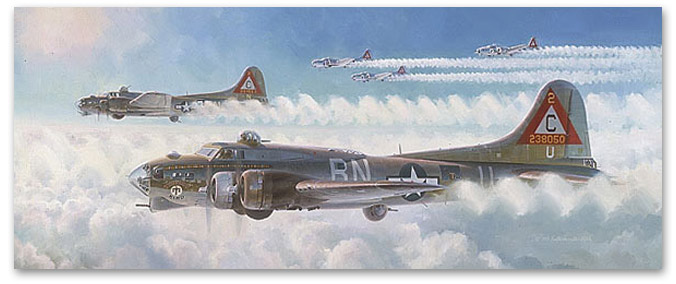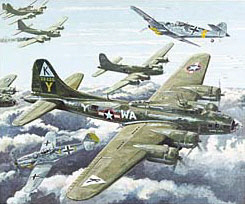|
 are acknowledged, affirmed and commemorated.
|
Posted on 01/17/2003 5:34:18 AM PST by SAMWolf
|
 are acknowledged, affirmed and commemorated.
|

|
|
|
Schweinfurt Oct. 14, 1943 Imagine if a squadron-sized unit simply failed to return to duty after taking part in a contingency.  That's precisely what confronted in the 305th Bombardment Group 59 years ago, following what is perhaps the greatest air battle in history. Rightly called "Black Thursday" by veterans, the Oct. 14, 1943 mission to Schweinfurt, Germany, was the most arduous of the war. Incredibly, of the 15 group aircraft able to participate in the mission, the Luftwaffe claimed 13, and 130 crewmembers. Of the downed airmen, 40 died and 20 were wounded, while another 79 became prisoners of war. Four airmen evaded capture and eventually returned to duty, while the remaining crewmen spent the war interned in Switzerland.  It took many months for the "Can Do" group to recover from the raid, and the wounds of that day are still felt by the group's veterans. The 305th BG had raided Schweinfurt before, on Aug. 17, 1943. The experience had been chilling, with much aerial opposition and flak, but the group held together and lost no aircraft. The "Black Thursday" Schweinfurt raid was completely different. Mistakes up and down the chain of command -- from security lapses to poor weather briefings -- led to unmitigated disaster for the Eighth Air Force and nearly halted the combined bombing offensive. Departing from the disciplined model of Col. Curtis LeMay, the group struggled with one problem after another in the bad weather that blanketed England. The group missed its assigned rendezvous with its element leader and every other subsequent navigational waypoint over England. Eventually, the 305th formed up on the wrong combat wing -- the 1st Combat Wing rather than the 40th -- becoming the "low group" in a very unconventional four-group alignment. Unlike England, the weather over occupied Europe was generally excellent for the defending fighters, only adding more misery to the 305th's longest day, as flak, fighters and coast watchers had no trouble plotting their course.  Rocket-firing German Messerschmitt-110s and Messerschmitt-210s destroyed most of the 305th BG before they even reached the Rhein River -- some 115 miles short of the target. Only three of the group's B-17s made it to the target area -- one of those crews released its bomb load while the aircraft burned. Only two 305th BG B-17s left Schweinfurt that day, and their crews managed to survive the long trip back to England by tucking into the 92nd Bomb Group's protective formation. Many tales of bravery transpired that day, such that unbelievable courage was the rule rather than the exception. Unfortunately, there weren't enough survivors to write many decoration packages. Since only two moderately damaged "Flying Fortresses" had taxied to the maintenance area, Lt. Col. Thomas McGehee, commander of the 305th, asked a returning crewman where the rest of the group's B-17s were. He received the most chilling reply in 305 AMW history. "Sir, there are no more ships," the crewman said. "We are the only ones left." The ground crews of the missing 13 aircraft refused to give up hope and desperately milled about the hardstands for hours until ordered to stand down. Leadership sometimes requires that higher headquarters be disappointed. Given the abysmal weather over England, the lack of coordination in the air, and the known, strong aerial opposition ahead, the Schweinfurt mission should have been scrubbed. Despite the odds, the Eighth Air Force had not turned back, had hit its intended target, and suffered the loss of more than 600 crewmen that day. As a result, the face of the bomber offensive changed almost immediately. Never again would the Eighth Air Force commit so many lives to deep penetrations of occupied Europe without adequate fighter protection. No group ever again suffered the horrendous 87-percent attrition rate the "Can Do" group did that October day. When the 42nd "Rainbow" Infantry Division liberated Schweinfurt in 1945, they sent the Nazi flag flying over the town hall to the men of the 305th Bombardment Group. Now housed at the Air Force Museum in Dayton, Ohio, the flag is inscribed with the simple words, "The Rainbow has avenged your losses at Schweinfurt." 
|

But you know what they say…
I don't think it will be long now Phil. I say your prayer daily. Thanks.
I know what you mean. I enjoy them, too. Unfortunately, I haven't got much time to post lately. I will try a bit harder.
Disclaimer: Opinions posted on Free Republic are those of the individual posters and do not necessarily represent the opinion of Free Republic or its management. All materials posted herein are protected by copyright law and the exemption for fair use of copyrighted works.